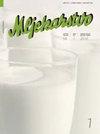驴奶与牛奶制克非尔的成分、感官特性及香气成分比较
IF 1.1
4区 农林科学
Q3 AGRICULTURE, DAIRY & ANIMAL SCIENCE
引用次数: 1
摘要
在这项研究中,用驴奶和牛奶制作开菲尔和开菲尔样品在5°C下储存21天,根据成分和微生物特性、挥发性香气化合物、氨基酸组成和感官分析对其进行了表征。与牛奶开菲尔(CMK)相比,驴乳开菲尔(DMK)的总固形物、脂肪和蛋白质含量较低。由于驴奶的总固体含量低,酪蛋白比例低,导致开菲尔样品的体特征较弱。DMK中乙醛和乙酸的生成量显著。此外,驴奶的乳糖含量高,使开菲尔酒的乙醇产量增加。酪氨酸、缬氨酸和精氨酸是DMK中的主要氨基酸。驴奶开菲尔在味觉和气味等感官特性方面被评价为可接受的。由此可见,利用驴奶生产益生菌发酵饮料是可行的。本文章由计算机程序翻译,如有差异,请以英文原文为准。
Comparison of composition, sensory properties and aroma compounds of kefir produced from donkey milk and cow milk
In this study, donkey milk and cow milk used for kefir production and the kefir samples were characterised based on compositional and microbiological properties, volatile aroma compounds, amino acid composition, and sensory analyses during storage for 21 days at 5 °C. Compared to cow milk kefir (CMK), donkey milk kefir (DMK) had lower contents of total solids, fat, and protein. Using donkey milk resulted in a weaker body characteristic in the kefir sample due to its low total solids content and the low ratio of casein. Acetaldehyde and acetic acid formation were at a remarkable level in DMK. Besides, the high lactose content of donkey milk caused more ethanol production in the kefir. Tyrosine, valine, and arginine were the primary amino acids in DMK. Donkey milk kefir was evaluated as acceptable in the aspect of sensorial properties such as taste and odour. Based on the present results, it could be concluded that a probiotic fermented beverage can be produced from donkey milk.
求助全文
通过发布文献求助,成功后即可免费获取论文全文。
去求助
来源期刊

Mljekarstvo
Agricultural and Biological Sciences-Animal Science and Zoology
CiteScore
1.90
自引率
41.70%
发文量
18
审稿时长
12 weeks
期刊介绍:
Mljekarstvo is an open access, peer-reviewed international quarterly scientific journal. The first issue was published in 1951, by the Croatian Dairy Operators'' Association (today: Croatian Dairy Union, publisher). In a paper at a Union conference held 28 October 1951 in Zagreb it was said: "Our desire is that this magazine does not meet the fate of its predecessors, but that it continues to reflect the creative efforts and to provide guidelines for the producers as well as all other operators employed in the dairy industry."
It is our pleasure today to say that wishes of the enthusiasts who attended the conference have come true, and the magazine Mljekarstvo during the last six decades was a reflection of the creative efforts of numerous dairy scientists and experts, and through its texts it served as a guideline in improving production and processing of milk and dairy products. Mljekarstvo has been following all the achievements of the dairy profession in Croatia, and it also gives the short surveys of world achievements. The result of the research of local and foreign scientists and experts always find their place in the magazine Mljekarstvo. It has been edited by our outstanding dairy experts employed at colleges, research institutions and dairy companies.
 求助内容:
求助内容: 应助结果提醒方式:
应助结果提醒方式:


